Aircraft Photography/Spotting Locations - Perth Airport (PER / YPPH)
TERMINAL 3 - DOMESTIC MULTI-USER TERMINAL
© 2011 David Eyre
Airlines Using This Terminal: |
Skywest Airlines, Tiger Airways Australia and Virgin Australia domestic flights operate from this terminal.
Other domestic flights, regional and GA aircraft taxy near the terminal. |
Opening Times: |
Open daily between the hours of 3.30am and 1.00am each day (i.e. closed between 1am and 3.30am). |
Location: |
Terminal 3 (Multi-User Domestic) is on the west side of the airport, at the northern end of Brearley Avenue. It can also be reached from Fauntleroy Avenue. |
HOW TO GET TO TERMINAL 3 (Multi-User Domestic): |
Terminal and Car Park Location Map |
Driving: |
Terminal 3 is located at the northern end of Brearley Avenue, but can also be reached from Fauntleroy Avenue.
Both roads are accessed from Great Eastern Highway. Tonkin Highway also has Domestic Airport exits for Great Eastern Highway.
There is also the Airport Link Road which runs between the domestic and international terminals.
Be mindful of speed limits - speed traps are sometimes set up on Brearley Avenue, Dunreath Road and the Airport Link Road.
Free shuttle buses run from the long-term parking areas to the terminal. .
Parking cost calculator |
Public Transport: |
Transperth operates a bus service (route 37) between Perth Airport's Domestic Terminals and the city of Perth.
If you need to travel from the International Terminal (Terminal 1) to/from the Domestic Terminals (T3 & T4), there is a FREE Terminal Transfer bus service. The trip takes about 8 minutes. To catch the Terminal Transfer bus, the bus stop is located at the front of the in front of Qantas Terminal 4 at the Domestic Terminals and the International Terminal Stop is near the Arrivals area.
The Perth Airport Connect shuttle bus service is also available for travel between the International Terminal (T1) and Perth City or Fremantle, but is expensive (almost the same as a taxi fare) - see Perth Airport Connect website for prices and schedules |
Taxi: |
The taxi stand is directly in front of Terminal 3, close to Terminal 4. Taxi cost calculator |
HOW TO GET TO THE ARRIVALS/DEPARTURES VIEWING AREA: |
Terminal 3 Map
The Departures Lounge viewing areas can be accessed by entering the terminal, then walking to the left side. You will be required to undergo security checks (just like passengers) and can then proceed to the escalator or lift to the first floor.
You can also walk through a hallway to Terminal 4, which is used for domestic flights by Qantas, QantasLink and Jetstar. |
NOTES:
- Photographs should not be taken of any staff or other members of the public without their express permission.
- Some windows are better than others for photography due to differing levels of window tinting, cleanliness and obstructions (e.g. aerobridges).
Advantages:
- Great for late morning and afternoon photography
- Lift and escalator available
- Under cover with glass windows
- Air conditioned
- Seating available
- Arrivals and Departures TV monitors
- Toilets
- Snack and drink vending machines
- Restaurants (Sumo Salad and Red Rooster) and cafes.
- Good views of traffic landing on runway 21 and taking off runway 03, but need a 300mm or above lens. Can get photos of aircraft taking off runway 21, but only during the initial part of take-off run.
- Good views of aircraft parked at Terminal 3 or taxying to/from or past the terminal.
|
Disadvantages:
- Early morning photography will be facing the sun.
- Double-layer glass windows, so reflections can be an issue for photography.
- Windows have differing levels of cleanliness and transparency - some are tinted, others are not.
- Aircraft parked at some bays will be partly obscured by terminal structures, aerobridges and ground equipment such as aircraft stairs.
- Lighting poles and terminal structure may cause shadows on aircraft in the late daylight hours.
- International terminal on opposite side of airport, so too far away for decent photos of international aircraft.
- Photographing aircraft on runways requires a telephoto lens of at least 300mm.
- Aircraft taking off runway 21 or 24 will usually be obscured by terrain, trees or structures at rotation - the same applies to aircraft touchdown point for landings on runway 03 and 06.
- Need to be mindful of parking costs
|
Photographic Equipment: Canon EOS 550D digital SLR with a Canon EF 100-400 mm F4.5-5.6L IS USM (telephoto zoom lens) with UV filter, Canon EF 70-300 mm 1:4.5-5.6 IS USM with Circular Polariser filter and Canon EF-S 17-55 mm 1:2.8 IS USM (wide-angle zoom lens) with Circular Polariser filter.
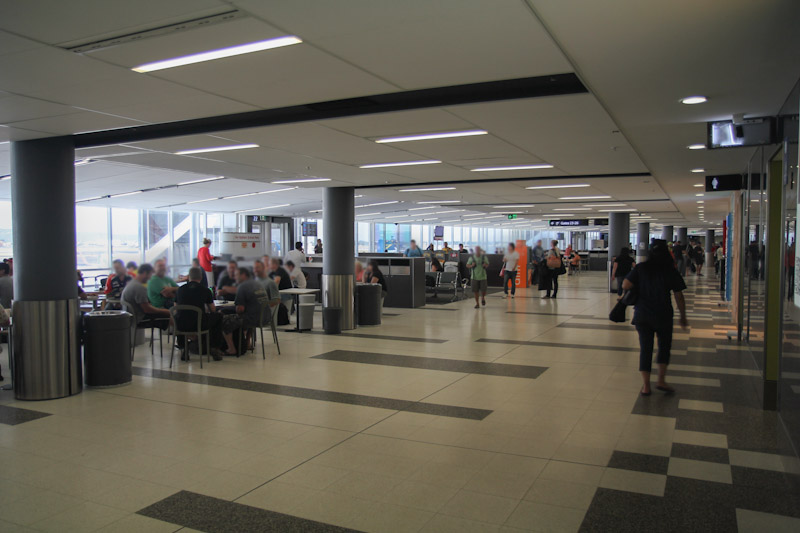 |
Terminal 3
Note how windows use different types of window tint. Some are clearer than others.
Photo © David Eyre |
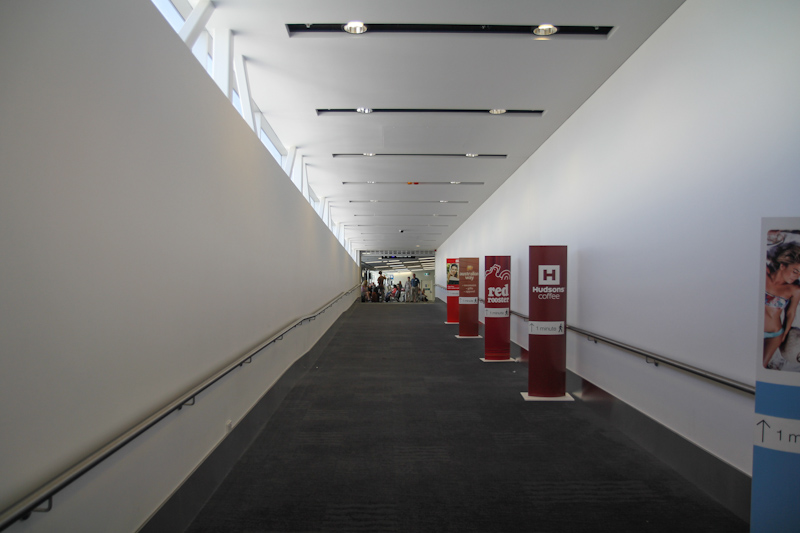 |
Hallway connecting Terminal 3 to Terminal 4 Qantas Domestic
Viewed here from Terminal 4.
Photo © David Eyre |
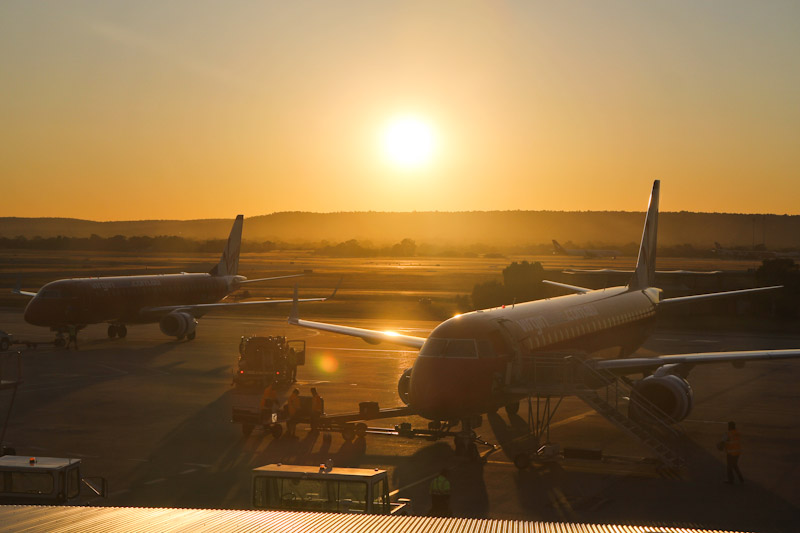 |
An early morning photo of two Virgin Australia Embraer 190s.
Photo © David Eyre |
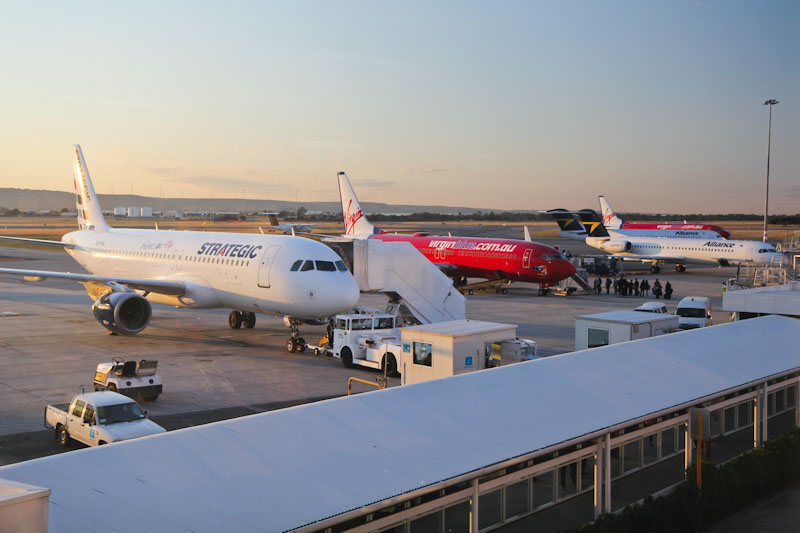 |
Although this older view is no longer possible due to recently-constructed aerobridges, the photo illustrates the variety of airlines using Tterminal 3.
Strategic Airlines later became Air Australia before ceasing operations. Virgin Blue is now Virgin Australia.
This is an early morning view.
Photo © David Eyre |
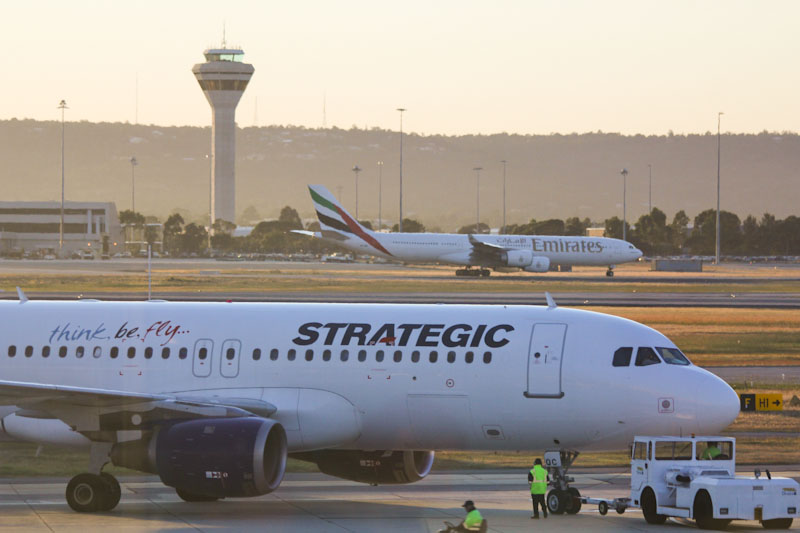 |
An older photo showing an early morning view of a Strategic Airlines A320 being pushed back as an Emirates A340-500 taxies out for departure from runway 03.
Photo © David Eyre |
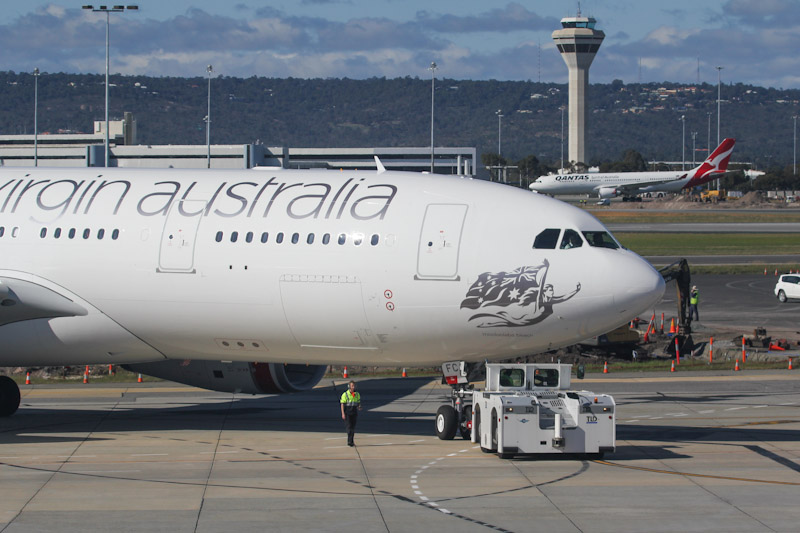 |
This recent photo, taken just after midday, shows a Virgin Australia Airbus A330-243 being towed onto Bay 19A. A new parking bay is being constructed behind.
The International Terminal and Control Tower are visible in the background (on the east side of the airport).
Photo © David Eyre |
 |
An older photo showing an early morning view of an Emirates A340-500 taking off from runway 03.
Photo © David Eyre |
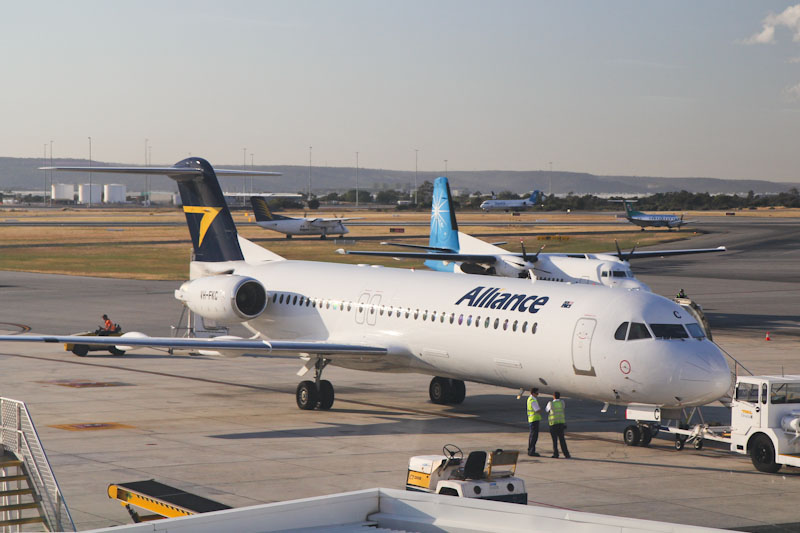 |
This photo illustrates some Fly In Fly Out (FIFO) charter flights, taking workers to various mining sites throughout Western Australia.
Photo © David Eyre
|
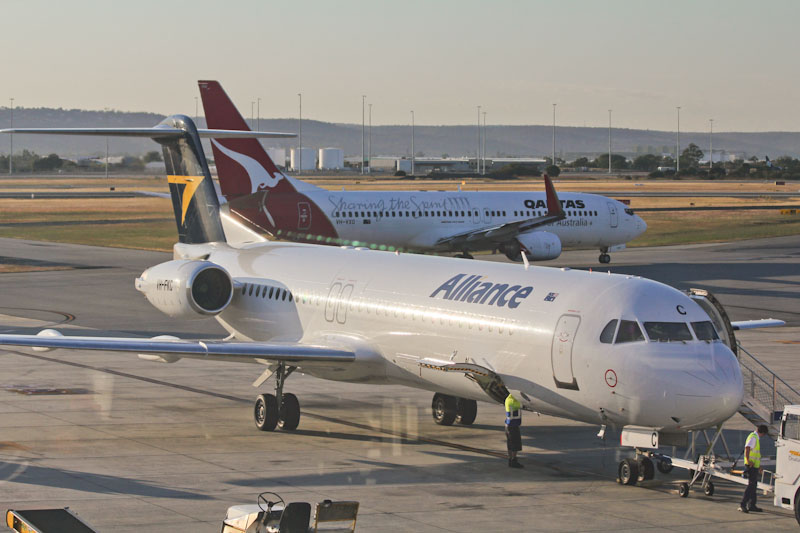

|
Window reflections (made worse by double-layered windows) and ground equipment can ruin some photos, regardless of whether it is morning (first photo) or afternoon (second photo).
Photos © David Eyre |
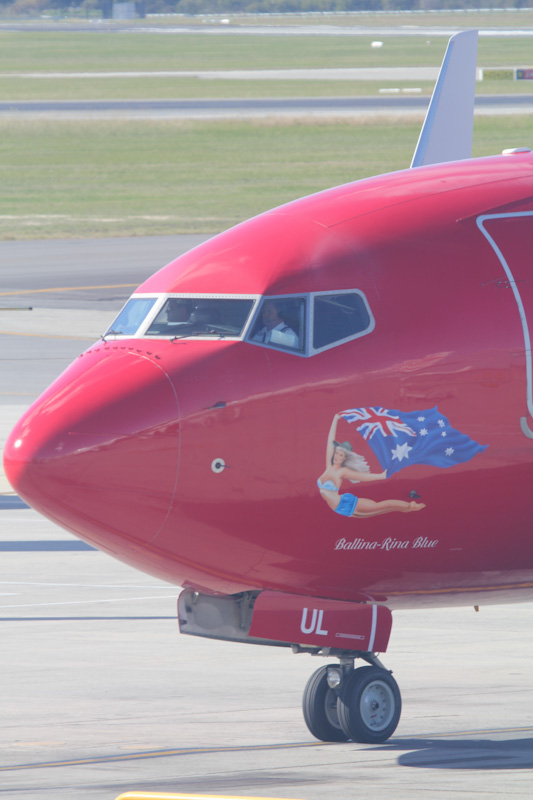
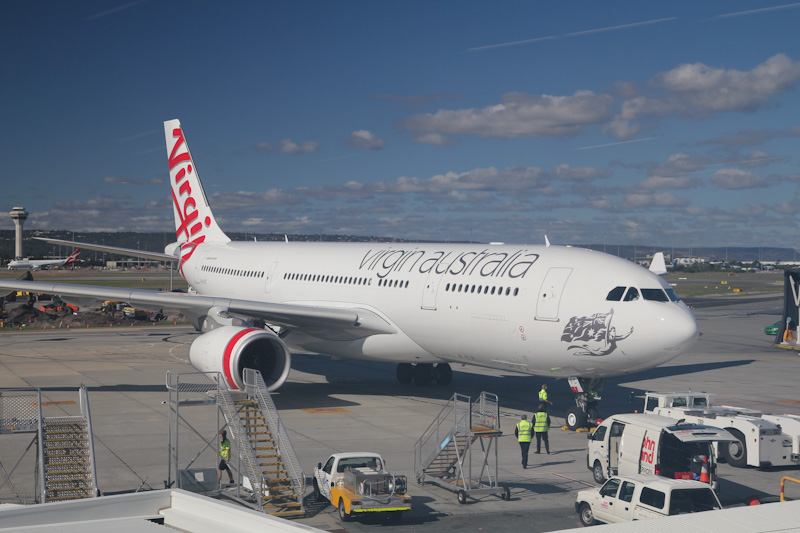
|
These unedited photos show how "milky" and reflective some of the windows are, due to having two layers of glass and different types of window tinting.
They were both taken just after midday on a winter's day in June 2012.
The first one shows a Virgin Australia 737-800 (in old Virgin Blue colours) parking on Bay 17, and the second one is a Virgin Australia Airbus A330-200 parked at Bay 19A.
Photos © David Eyre |
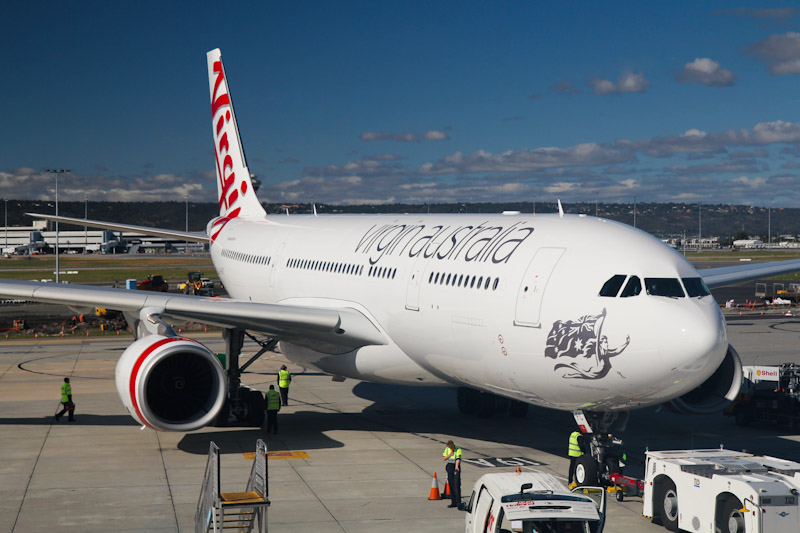 |
Taken through a different window to the photo above. This shows that with care taken to avoid reflections and some photo editing, reasonable photos are possible, although the ground equipment can be a problem.
Photo © David Eyre |
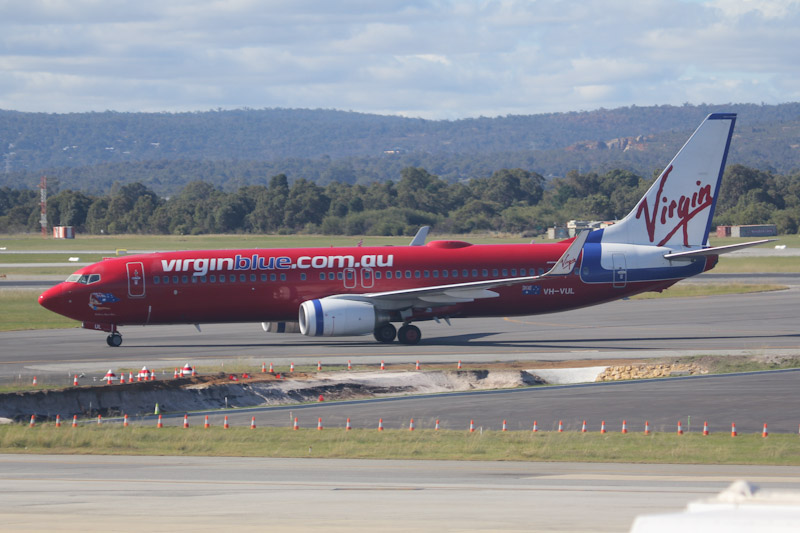
|
Another unedited photo of a Virgin Australia Boeing 737-8FE (in the old Virgin Blue colours) taxying in along taxiway D.
New aircraft parking areas and lighting poles were being constructed at the time of these photos (June 2012) - seen here surrounded by cones.
Photo © David Eyre |
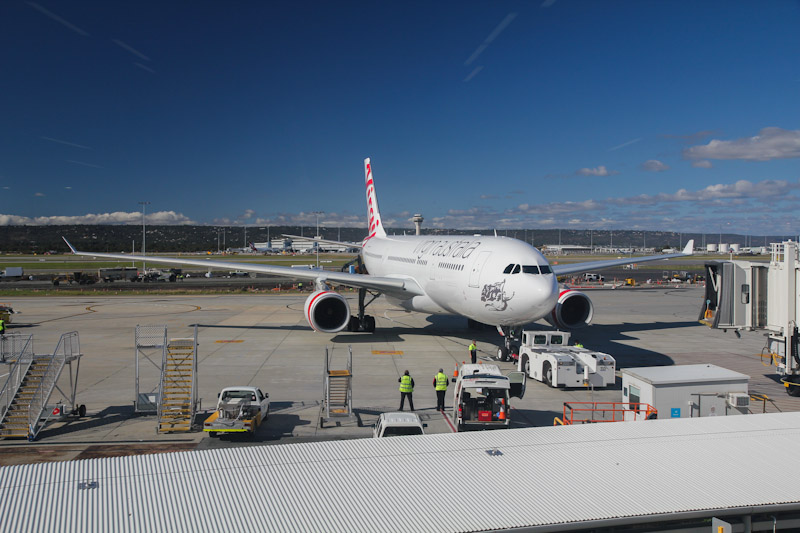 |
This photo shows a Virgin Australia Airbus A330-243 being towed onto Bay 19A, with the International Terminal and Control Tower visible in the background, on the east side of the airport.
This view shows:
- window reflection problems
- ground equipment and terminal structures in the foreground
- construction equipment and new lighting poles behind the aircraft
- the view of runways and the International Terminal from Terminal 3
Photo © David Eyre |
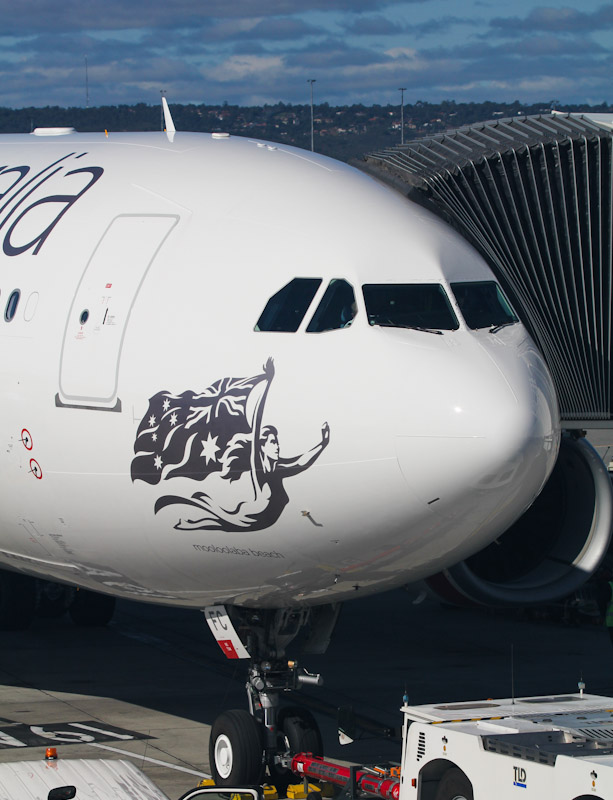
|
A close-up of a Virgin Australia Airbus A330-243 parked at Bay 19A.
Photo © David Eyre |
|
















